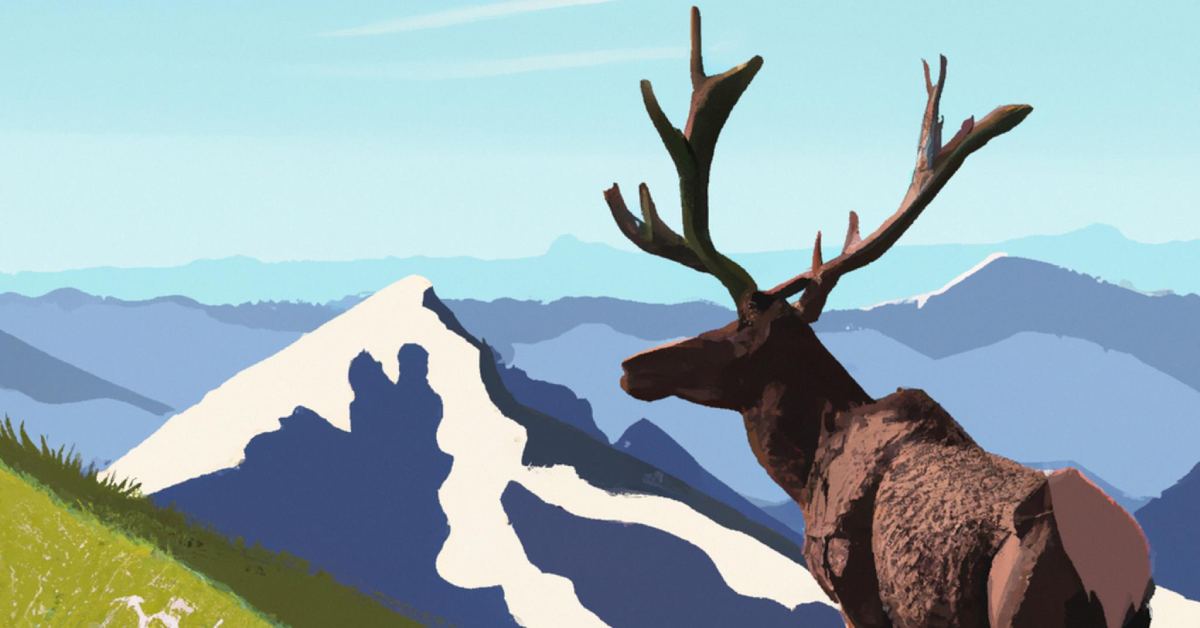Introduction
Antlers are one of nature's most fascinating and enigmatic creations. These majestic appendages adorn the heads of various wildlife species, including deer, elk, moose, caribou, and more. While antlers are commonly associated with strength and virility, there's a lesser-known aspect of their existence that adds a layer of intrigue to these natural weapons: the antler sheds themselves.
Antler sheds, in this context, refer to the cast-off antlers that these animals naturally shed and regrow each year. In this article, we will delve into the world of antler sheds, exploring the shedding process, the remarkable regrowth, and the timing of this incredible cycle.
Section I: The Purpose of Antlers
Antlers serve a multifaceted purpose in the lives of deer, elk, moose, caribou, and other antlered species. While they are often associated with aesthetics and majestic displays, antlers play vital roles in the animals' survival and reproduction. Here are some of the key reasons why these creatures go through the cycle of growing and shedding their antlers:
Mating and Attraction
One of the primary functions of antlers is to attract mates. During the mating season, also known as the rut, male deer and other antlered species use their impressive antlers to establish dominance and compete for the attention of females. Larger and more elaborately branched antlers are often seen as a sign of strength and genetic fitness, making them attractive to potential mates.
Defense and Predation
Antlers also serve as formidable weapons for defense and protection against predators. When faced with threats, these animals can use their antlers to ward off attackers, whether it's a rival of the same species or a potential predator like wolves or cougars. Antlers are not only for display; they are functional tools in the fight for survival.
Resource Competition
Deer and other herbivorous species rely on vegetation for sustenance. During times of resource scarcity, such as the harsh winter months, antlers can be used as tools for accessing food. They help in clearing away snow, reaching high branches, or digging through the ground in search of plant roots and tubers. In this way, antlers contribute to the animal's ability to secure nourishment during challenging times.
Age and Dominance
Antlers are also indicators of age and dominance within a population. As these animals age, their antlers tend to grow larger and more robust. Dominant individuals with imposing antlers are more likely to secure access to prime feeding areas and mating opportunities. Younger or less dominant males may have smaller antlers, and as they mature, they undergo the annual cycle of shedding and regrowing to potentially develop more impressive antlers.
Health and Vitality
The ability to grow and maintain healthy antlers is closely tied to an individual's overall health and vitality. Animals that are well-nourished and in good physical condition tend to grow larger and more symmetrical antlers. Therefore, the shedding and regrowth of antlers can serve as an indirect indicator of an animal's fitness and ability to thrive in its environment.
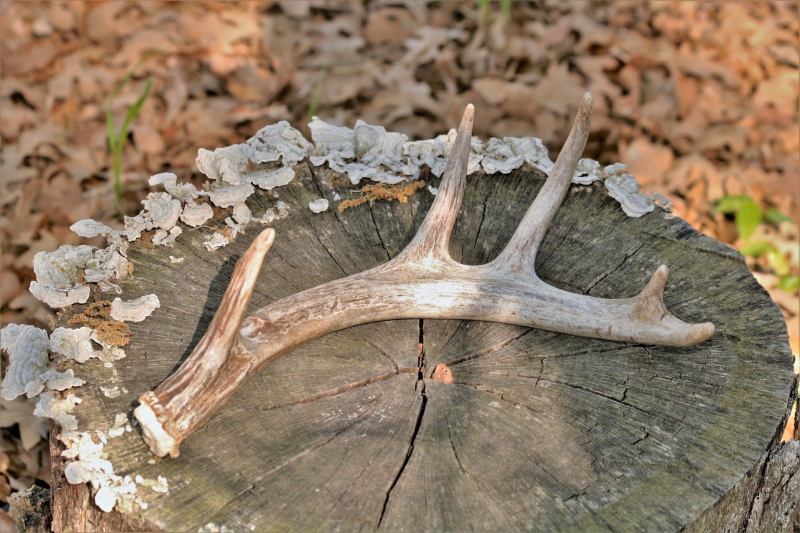
Caption: The photo shows a whitetail deer antler shed lying on a tree stump in the autumn. Copyright: Sheila Brown
Section II: Understanding Antler Sheds: Composition and Characteristics
Antler sheds, the cast-off antlers of deer, elk, moose, caribou, and similar species, are remarkable natural structures with unique properties. To gain a deeper understanding, let's explore what antler sheds are made of, how they are formed, and some of their key characteristics:
Composition
Antler sheds are primarily composed of bone. Unlike permanent horns found in some animals, antlers are made of a bony substance known as "trabecular bone." This type of bone is porous and lightweight, which is essential for the rapid growth of antlers each year. Additionally, antlers contain proteins, minerals, and growth factors, contributing to their strength and structure.
Formation
The formation of antlers is a fascinating process. Antlers begin to grow from the pedicles, which are bony bases located on the animal's skull. The pedicles contain specialized cells called "osteoblasts," responsible for depositing new bone tissue. As the animal's body prepares for the annual growth cycle, hormonal changes stimulate the activity of these cells, leading to the rapid development of antlers.
Size and Weight
The size and weight of antler sheds can vary significantly among species and individuals. Factors such as genetics, age, nutrition, and overall health influence the size of antlers. Some antler sheds can be relatively small, while others, particularly those of mature males in peak condition, can be massive and impressive. Antler size is often used as an indicator of an individual's health and genetic fitness.
Regarding weight, antler sheds are surprisingly lightweight for their size due to the porous nature of trabecular bone. Smaller antlers may weigh only a few pounds, while larger and more elaborate ones can reach weights of 10 to 20 pounds or even more. Despite their size, this lightweight design allows the animals to carry and use them effectively.
Antler Velvet
During the initial stages of antler growth, the antlers are covered in a soft, fuzzy skin called velvet. This velvet layer is rich in blood vessels, which nourish the antlers and aid in their growth. While in the velvet stage, antlers are highly sensitive, and animals take great care to avoid damaging them. As the antlers mature, the velvet dries up and falls away, revealing the hardened bone beneath.
Antler sheds, in their natural state, provide a fascinating glimpse into the biology and adaptation of these animals. Their composition, formation, size, and weight are intricately tied to the unique life cycle of antlered species, making them an integral part of the animal kingdom's wonders.
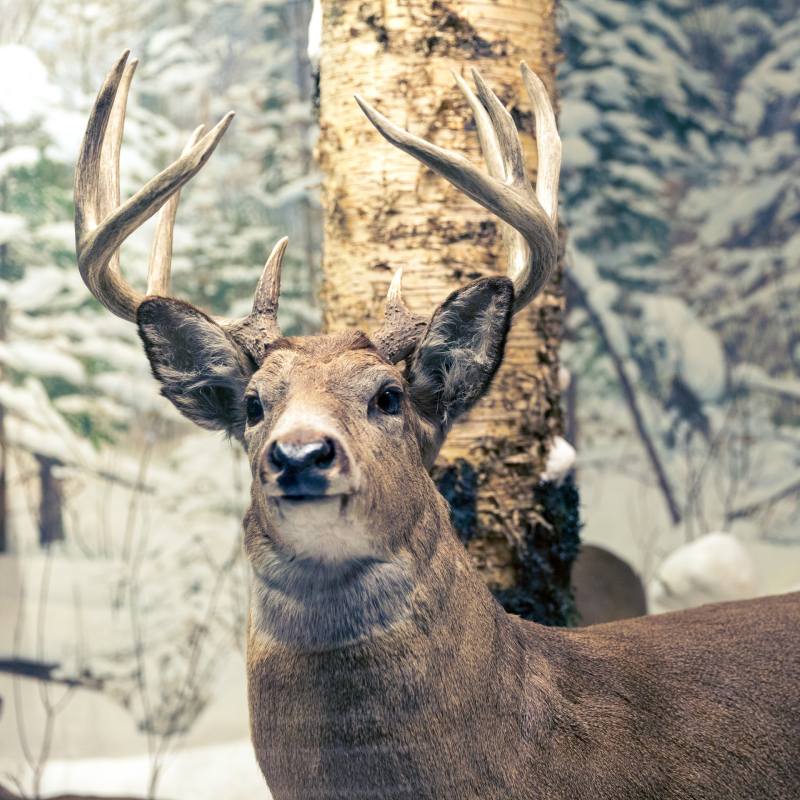
Caption: The photo above shows a whitetail deer in a forest during the winter time, with both antlers still attached. Copyright: Petr Kratochvil
Section III: The Shedding Process
One of the most captivating aspects of antlers is their seasonal shedding. The process of antler shedding, scientifically known as "antler abscission," is a naturally highly coordinated and regulated event that occurs primarily in males of antlered species. Here's a closer look at how this remarkable process unfolds:
- Hormonal Changes: The shedding process is initiated by hormonal changes triggered by the changing photoperiod, or the length of daylight. As the days shorten, the pineal gland in the brain releases melatonin, signaling to the animal's body that it's time to begin the process of shedding antlers.
- Resorption of Bone: As the hormonal signals take effect, the bone at the base of the antlers, called the pedicle, begins to weaken. The pedicle contains specialized cells called osteoclasts that break down the bone tissue. This resorption process is critical for the eventual detachment of the antlers.
- Separation: Once the bone at the pedicle weakens sufficiently, the antlers become detached from the animal's head. This process is painless and is akin to losing a deciduous tooth. The antlers fall away, leaving behind a raw, blood-covered area on the animal's head.
- Rapid Healing: Surprisingly, the open wounds left behind after antler shedding heal remarkably quickly. The animal's body activates a clotting mechanism and rapidly covers the exposed bone with skin and fur. This protective layer shields the vulnerable area from infections.
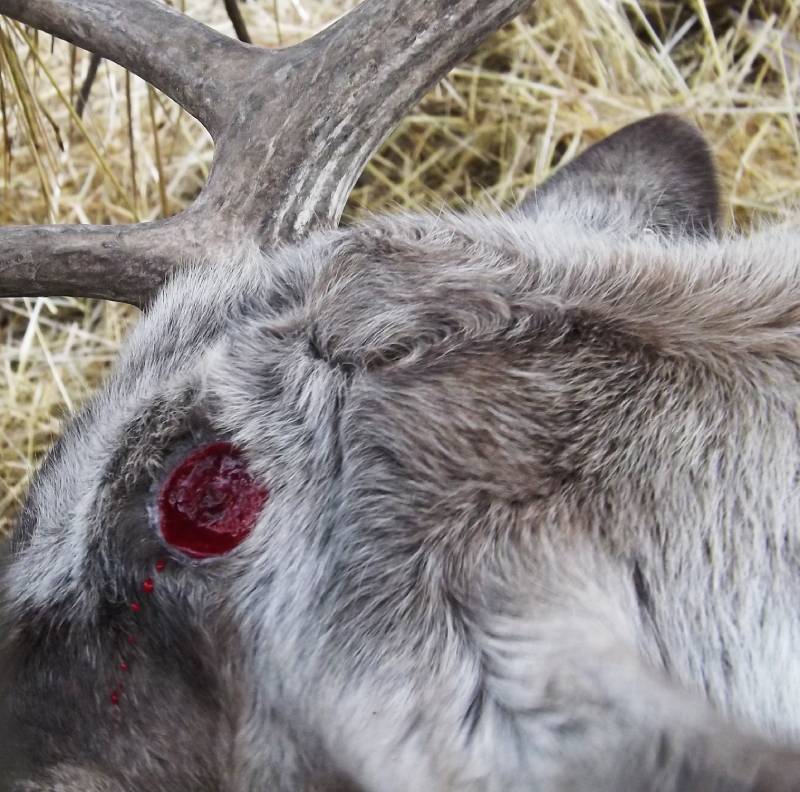
Caption: Following the breeding season, a decline in testosterone levels triggers a process involving specialized cells known as osteoclasts. These cells work to break down the tissue that connects the burr (the base of the antler) and the pedicle (the antler's growth plates). This specific point of separation is commonly referred to as the "abscission line". Ultimately, the antler is shed, and it naturally falls off due to its own weight. The photo shows a fresh the "abscission line" after a freshly shed antler. Copyright: Kiss Áron
[ Related Article: Does Antler Shedding Hurt? ]
Section IV: The Growth of New Antlers
After the shedding of antlers, the Cervidae (deer) family members embark on the impressive journey of regrowing these iconic structures. The process of growing new antlers, scientifically termed "antlerogenesis," is a testament to nature's resilience and adaptation. Here's how it happens:
- Activation of Growth Centers: As the shedding season ends, hormonal changes once again come into play. This time, the pituitary gland releases hormones like testosterone and insulin-like growth factor 1 (IGF-1), which activate the growth centers in the pedicles.
- Rapid Growth: Antlers grow astonishingly fast, often at a rate of up to half an inch per day. This rapid growth is powered by the rich blood supply to the antlers, which provides the necessary nutrients and oxygen.
- Velvet Stage: Initially, the growing antlers are covered in a soft, fuzzy skin called velvet. This velvet layer is rich in blood vessels, which nourish the antlers and aid in their growth. During this stage, the antlers are extremely sensitive, and the animals take great care to avoid damaging them.
- Mineralization: Over time, the antlers undergo a process of mineralization, gradually hardening and losing their velvet covering. The minerals, particularly calcium and phosphorus, are deposited in the antlers, making them strong and durable.
- Completion: The entire process, from the initial growth of tiny nubs to fully developed antlers, can take several months, depending on the species and individual factors. Once the antlers are fully formed and hardened, they are ready for their various uses, such as attracting mates, establishing dominance, and defending against predators.
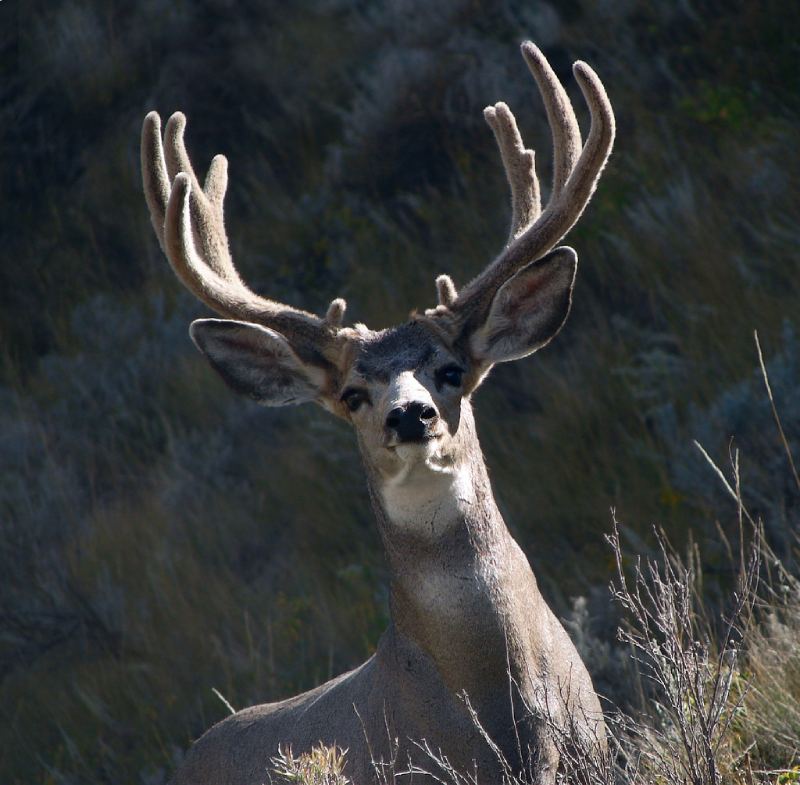
Caption: Captured in western North Dakota, the photo above features a mule deer. Notice the soft, fuzzy covering on the antler, commonly known as 'velvet'. Copyright: Matt Reinbold
Section V: Timing of Antler Shedding
The timing of antler shedding varies among different species and is influenced by environmental factors, genetics, and individual health. Let's take a closer look at the shedding schedule for some of the most well-known members of the Cervidae family:
- White-Tailed Deer: White-tailed deer, commonly found in North America, typically shed their antlers in late winter to early spring, usually between December and March. The exact timing can vary depending on geographic location and individual factors.
- Elk: Elk, known for their impressive antlers, typically shed them in late winter, similar to white-tailed deer. Shedding usually occurs between February and April.
- Moose: Moose have the largest antlers of any cervid species. They typically shed their antlers in late winter or early spring, with shedding taking place between January and April.
- Caribou: Caribou, also known as reindeer in some regions, have antlers adapted for cold climates. They typically shed their antlers in late winter to early spring, often between February and April.
- Red Deer: In Europe, red deer are a prominent species with impressive antlers. They tend to shed their antlers in late winter, between February and April.
- Roe Deer: Roe deer, a smaller species found in Europe, usually shed their antlers in late autumn, between November and December.
It's important to note that the shedding schedule can vary not only by species but also by age and individual health. Factors such as nutrition and overall physical condition can influence the timing of antler shedding and regrowth.
Conclusion
Antlers are a symbol of power, grace, and the beauty of the natural world. However, behind their magnificence lies a remarkable cycle of shedding and regrowth that showcases the intricate workings of nature. From the hormonal triggers that initiate the shedding process to the rapid growth of new antlers, this annual cycle is a testament to the adaptability and resilience of the animal kingdom.
As we observe deer, elk, moose, caribou, and other antlered species in the wild, we can now appreciate the temporary nature of these majestic appendages. The shedding and regrowth of antlers are not just biological processes; they are an integral part of the lives of these creatures, influencing their behavior, reproduction, and survival. Understanding the science behind antler sheds allows us to marvel at the complexity of nature and the wonders of the animal kingdom.

